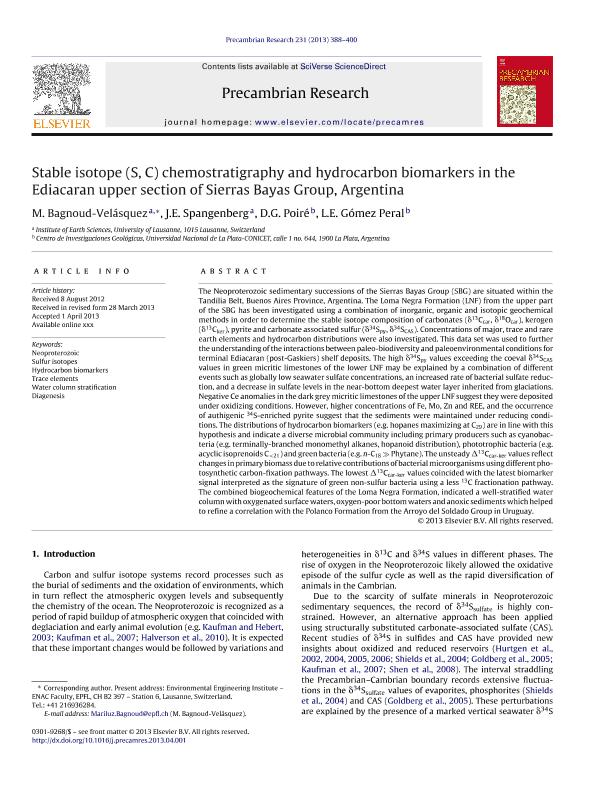Mostrar el registro sencillo del ítem
dc.contributor.author
Bagnoud Velasquez, M.
dc.contributor.author
Spangenberg, J. E.
dc.contributor.author
Poire, Daniel Gustavo

dc.contributor.author
Gómez Peral, Lucia

dc.date.available
2017-09-13T15:16:02Z
dc.date.issued
2013-07
dc.identifier.citation
Bagnoud Velasquez, M.; Spangenberg, J. E.; Poire, Daniel Gustavo; Gómez Peral, Lucia; Stable isotope (S, C) chemostratigraphy and hydrocarbon biomarkers in the Ediacaran upper section of Sierras Bayas Group, Argentina; Elsevier Science; Precambrian Research; 231; 7-2013; 388-400
dc.identifier.issn
0301-9268
dc.identifier.uri
http://hdl.handle.net/11336/24126
dc.description.abstract
The Neoproterozoic sedimentary successions of the Sierras Bayas Group (SBG) are situated within the Tandilia Belt, Buenos Aires Province, Argentina. The Loma Negra Formation (LNF) from the upper part of the SBG has been investigated using a combination of inorganic, organic and isotopic geochemical methods in order to determine the stable isotope composition of carbonates (δ13Ccar, δ18Ocar), kerogen (δ13Cker), pyrite and carbonate associated sulfur (δ34Spy, δ34SCAS). Concentrations of major, trace and rare earth elements and hydrocarbon distributions were also investigated. This data set was used to further the understanding of the interactions between paleo-biodiversity and paleoenvironmental conditions for terminal Ediacaran (post-Gaskiers) shelf deposits. The high δ34Spy values exceeding the coeval δ34SCAS values in green micritic limestones of the lower LNF may be explained by a combination of different events such as globally low seawater sulfate concentrations, an increased rate of bacterial sulfate reduction, and a decrease in sulfate levels in the near-bottom deepest water layer inherited from glaciations. Negative Ce anomalies in the dark grey micritic limestones of the upper LNF suggest they were deposited under oxidizing conditions. However, higher concentrations of Fe, Mo, Zn and REE, and the occurrence of authigenic 34S-enriched pyrite suggest that the sediments were maintained under reducing conditions. The distributions of hydrocarbon biomarkers (e.g. hopanes maximizing at C29) are in line with this hypothesis and indicate a diverse microbial community including primary producers such as cyanobacteria (e.g. terminally-branched monomethyl alkanes, hopanoid distribution), phototrophic bacteria (e.g. acyclic isoprenoids C<21) and green bacteria (e.g. n-C18 ≫ Phytane). The unsteady Δ13Ccar-ker values reflect changes in primary biomass due to relative contributions of bacterial microorganisms using different photosynthetic carbon-fixation pathways. The lowest Δ13Ccar-ker values coincided with the latest biomarker signal interpreted as the signature of green non-sulfur bacteria using a less 13C fractionation pathway. The combined biogeochemical features of the Loma Negra Formation, indicated a well-stratified water column with oxygenated surface waters, oxygen-poor bottom waters and anoxic sediments which helped to refine a correlation with the Polanco Formation from the Arroyo del Soldado Group in Uruguay.
dc.format
application/pdf
dc.language.iso
eng
dc.publisher
Elsevier Science

dc.rights
info:eu-repo/semantics/openAccess
dc.rights.uri
https://creativecommons.org/licenses/by-nc-sa/2.5/ar/
dc.subject
Neoproterozoic
dc.subject
Sulfur Isotopes
dc.subject
Hydrocarbon Biomarkers
dc.subject
Trace Elements
dc.subject
Water Column Stratification
dc.subject
Diagenesis
dc.subject.classification
Oceanografía, Hidrología, Recursos Hídricos

dc.subject.classification
Ciencias de la Tierra y relacionadas con el Medio Ambiente

dc.subject.classification
CIENCIAS NATURALES Y EXACTAS

dc.title
Stable isotope (S, C) chemostratigraphy and hydrocarbon biomarkers in the Ediacaran upper section of Sierras Bayas Group, Argentina
dc.type
info:eu-repo/semantics/article
dc.type
info:ar-repo/semantics/artículo
dc.type
info:eu-repo/semantics/publishedVersion
dc.date.updated
2017-09-06T17:16:39Z
dc.journal.volume
231
dc.journal.pagination
388-400
dc.journal.pais
Países Bajos

dc.journal.ciudad
Amsterdam
dc.description.fil
Fil: Bagnoud Velasquez, M.. Universite de Lausanne; Suiza
dc.description.fil
Fil: Spangenberg, J. E.. Universite de Lausanne; Suiza
dc.description.fil
Fil: Poire, Daniel Gustavo. Consejo Nacional de Investigaciones Científicas y Técnicas. Centro Científico Tecnológico Conicet - La Plata. Centro de Investigaciones Geológicas. Universidad Nacional de La Plata. Facultad de Ciencias Naturales y Museo. Centro de Investigaciones Geológicas; Argentina
dc.description.fil
Fil: Gómez Peral, Lucia. Consejo Nacional de Investigaciones Científicas y Técnicas. Centro Científico Tecnológico Conicet - La Plata. Centro de Investigaciones Geológicas. Universidad Nacional de La Plata. Facultad de Ciencias Naturales y Museo. Centro de Investigaciones Geológicas; Argentina
dc.journal.title
Precambrian Research

dc.relation.alternativeid
info:eu-repo/semantics/altIdentifier/url/http://linkinghub.elsevier.com/retrieve/pii/S0301926813001162
dc.relation.alternativeid
info:eu-repo/semantics/altIdentifier/doi/http://dx.doi.org/10.1016/j.precamres.2013.04.001
Archivos asociados
